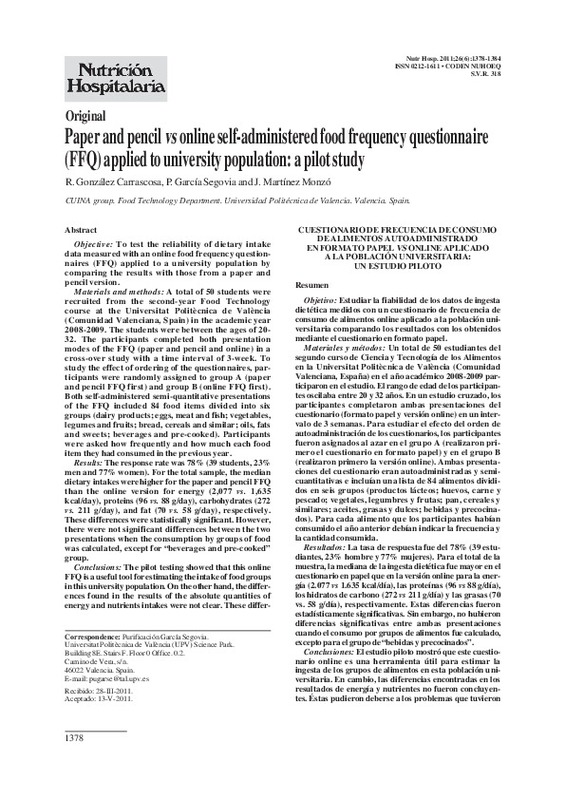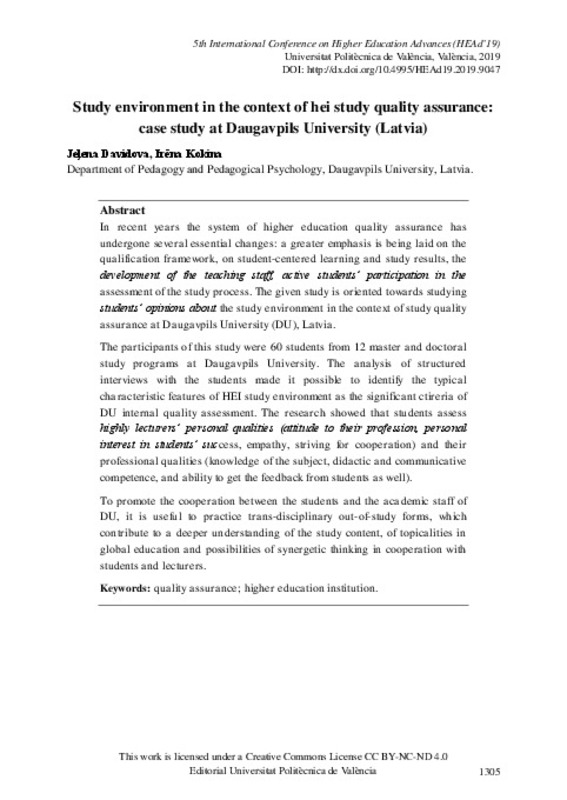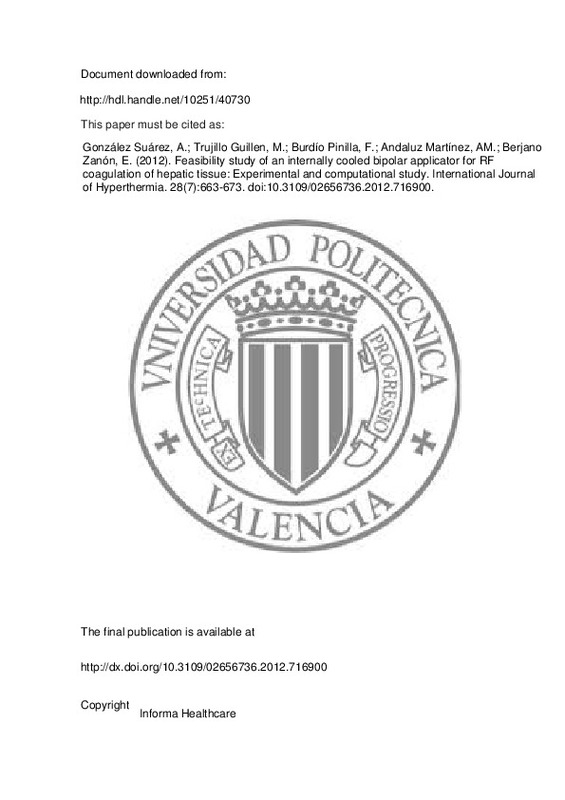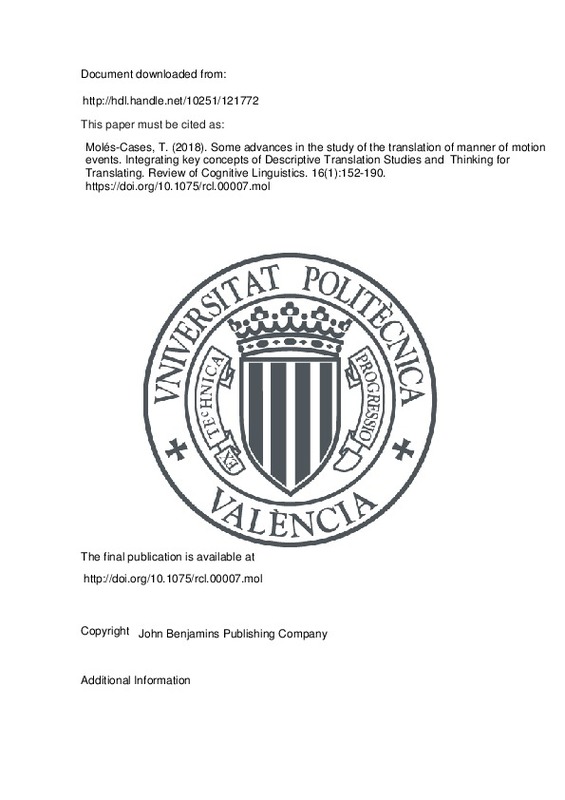JavaScript is disabled for your browser. Some features of this site may not work without it.
Buscar en RiuNet
Listar
Mi cuenta
Estadísticas
Ayuda RiuNet
Admin. UPV
Paper and pencil vs online self-administered food frequency questionnaire(FFQ) applied to university population: a pilot study
Mostrar el registro sencillo del ítem
Ficheros en el ítem
| dc.contributor.author | González Carrascosa, Rebeca
|
es_ES |
| dc.contributor.author | García Segovia, Purificación
|
es_ES |
| dc.contributor.author | Martínez Monzó, Javier
|
es_ES |
| dc.date.accessioned | 2013-04-29T11:37:00Z | |
| dc.date.available | 2013-04-29T11:37:00Z | |
| dc.date.issued | 2011-06 | |
| dc.identifier.issn | 0212-1611 | |
| dc.identifier.uri | http://hdl.handle.net/10251/28304 | |
| dc.description.abstract | Objective: To test the reliability of dietary intake data measured with an online food frequency questionnaires (FFQ) applied to a university population by comparing the results with those from a paper and pencil version. Materials and methods: A total of 50 students were recruited from the second-year Food Technology course at the Universitat Politècnica de València (Comunidad Valenciana, Spain) in the academic year 2008-2009. The students were between the ages of 20- 32. The participants completed both presentation modes of the FFQ (paper and pencil and online) in a cross-over study with a time interval of 3-week. To study the effect of ordering of the questionnaires, participants were randomly assigned to group A (paper and pencil FFQ first) and group B (online FFQ first). Both self-administered semi-quantitative presentations of the FFQ included 84 food items divided into six groups (dairy products; eggs, meat and fish; vegetables, legumes and fruits; bread, cereals and similar; oils, fats and sweets; beverages and pre-cooked). Participants were asked how frequently and how much each food item they had consumed in the previous year. Results: The response rate was 78% (39 students, 23% men and 77% women). For the total sample, the median dietary intakes were higher for the paper and pencil FFQ than the online version for energy (2,077 vs. 1,635 kcal/day), proteins (96 vs. 88 g/day), carbohydrates (272 vs. 211 g/day), and fat (70 vs. 58 g/day), respectively. These differences were statistically significant. However, there were not significant differences between the two presentations when the consumption by groups of food was calculated, except for "beverages and pre-cooked" group. Conclusions: The pilot testing showed that this online FFQ is a useful tool for estimating the intake of food groups in this university population. On the other hand, the differences found in the results of the absolute quantities of energy and nutrients intakes were not clear. These differences could be due to the problems that the participants had for reporting portion size in the paper and pencil FFQ as photographs of portion sizes were not presented. | es_ES |
| dc.description.abstract | [ES] Objetivo: Estudiar la fiabilidad de los datos de ingesta dietética medidos con un cuestionario de frecuencia de consumo de alimentos online aplicado a la población universitaria comparando los resultados con los obtenidos mediante el cuestionario en formato papel. Materiales y métodos: Un total de 50 estudiantes del segundo curso de Ciencia y Tecnología de los Alimentos en la Universitat Politècnica de València (Comunidad Valenciana, España) en el año académico 2008-2009 participaron en el estudio. El rango de edad de los participantes oscilaba entre 20 y 32 años. En un estudio cruzado, los participantes completaron ambas presentaciones del cuestionario (formato papel y versión online) en un intervalo de 3 semanas. Para estudiar el efecto del orden de autoadministración de los cuestionarios, los participantes fueron asignados al azar en el grupo A (realizaron primero el cuestionario en formato papel) y en el grupo B (realizaron primero la versión online). Ambas presentaciones del cuestionario eran autoadministradas y semicuantitativas e incluían una lista de 84 alimentos divididos en seis grupos (productos lácteos; huevos, carne y pescado; vegetales, legumbres y frutas; pan, cereales y similares; aceites, grasas y dulces; bebidas y precocinados). Para cada alimento que los participantes habían consumido el año anterior debían indicar la frecuencia y la cantidad consumida. Resultados:La tasa de respuesta fue del 78% (39 estudiantes, 23% hombre y 77% mujeres). Para el total de la muestra, la mediana de la ingesta dietética fue mayor en el cuestionario en papel que en la versión online para la energía (2.077 vs 1.635 kcal/día), las proteínas (96 vs 88 g/día), los hidratos de carbono (272 vs 211 g/día) y las grasas (70 vs. 58 g/día), respectivamente. Estas diferencias fueron estadísticamente significativas. Sin embargo, no hubieron diferencias significativas entre ambas presentaciones cuando el consumo por grupos de alimentos fue calculado, excepto para el grupo de ¿bebidas y precocinados¿. Conclusiones:El estudio piloto mostró que este cuestionario online es una herramienta útil para estimar la ingesta de los grupos de alimentos en esta población universitaria. En cambio, las diferencias encontradas en los resultados de energía y nutrientes no fueron concluyentes. Éstas pudieron deberse a los problemas que tuvieron los participantes para indicar el tamaño de porción ingerida en el cuestionario en papel porque las fotografías de los tamaños de ración no se mostraban. | es_ES |
| dc.description.sponsorship | Gonzalez-Carrascosa, R. has a predoctoral scholarship of the Generalitat Valenciana (Spain). | en_EN |
| dc.language | Inglés | es_ES |
| dc.publisher | Grupo Aula Médica, S.L. | es_ES |
| dc.relation.ispartof | Nutricion Hospitalaria | es_ES |
| dc.rights | Reserva de todos los derechos | es_ES |
| dc.subject | Diet | es_ES |
| dc.subject | Food frequency questionnaire | es_ES |
| dc.subject | Online | es_ES |
| dc.subject | University population | es_ES |
| dc.subject | Adult | es_ES |
| dc.subject | Article | es_ES |
| dc.subject | Body weight | es_ES |
| dc.subject | Caloric intake | es_ES |
| dc.subject | Carbohydrate diet | es_ES |
| dc.subject | Clinical trial | es_ES |
| dc.subject | Comparative study | es_ES |
| dc.subject | Controlled clinical trial | es_ES |
| dc.subject | Controlled study | es_ES |
| dc.subject | Crossover procedure | es_ES |
| dc.subject | Fat intake | es_ES |
| dc.subject | Feeding behavior | es_ES |
| dc.subject | Female | es_ES |
| dc.subject | Food | es_ES |
| dc.subject | Food preference | es_ES |
| dc.subject | Human | es_ES |
| dc.subject | Internet | es_ES |
| dc.subject | Lifestyle | es_ES |
| dc.subject | Male | es_ES |
| dc.subject | Methodology | es_ES |
| dc.subject | Motor activity | es_ES |
| dc.subject | Pilot study | es_ES |
| dc.subject | Protein intake | es_ES |
| dc.subject | Questionnaire | es_ES |
| dc.subject | Randomized controlled trial | es_ES |
| dc.subject | Reproducibility | es_ES |
| dc.subject | Smoking | es_ES |
| dc.subject | Statistical analysis | es_ES |
| dc.subject | University | es_ES |
| dc.subject | Cross-Over Studies | es_ES |
| dc.subject | Data Interpretation, Statistical | es_ES |
| dc.subject | Diet Surveys | es_ES |
| dc.subject | Dietary Carbohydrates | es_ES |
| dc.subject | Dietary Fats | es_ES |
| dc.subject | Dietary Proteins | es_ES |
| dc.subject | Energy Intake | es_ES |
| dc.subject | Food Habits | es_ES |
| dc.subject | Food Preferences | es_ES |
| dc.subject | Humans | es_ES |
| dc.subject | Life Style | es_ES |
| dc.subject | Pilot Projects | es_ES |
| dc.subject | Questionnaires | es_ES |
| dc.subject | Reproducibility of Results | es_ES |
| dc.subject | Universities | es_ES |
| dc.subject | Young Adult | es_ES |
| dc.subject.classification | TECNOLOGIA DE ALIMENTOS | es_ES |
| dc.title | Paper and pencil vs online self-administered food frequency questionnaire(FFQ) applied to university population: a pilot study | es_ES |
| dc.title.alternative | CUESTIONARIO DE FRECUENCIA DE CONSUMO DE ALIMENTOS AUTOADMINISTRADO EN FORMATO PAPEL VSONLINE APLICADO A LA POBLACIÓN UNIVERSITARIA: UN ESTUDIO PILOTO | es_ES |
| dc.type | Artículo | es_ES |
| dc.identifier.doi | 10.3305/nh.2011.26.6.5261 | |
| dc.rights.accessRights | Abierto | es_ES |
| dc.contributor.affiliation | Universitat Politècnica de València. Departamento de Tecnología de Alimentos - Departament de Tecnologia d'Aliments | es_ES |
| dc.description.bibliographicCitation | González Carrascosa, R.; García Segovia, P.; Martínez Monzó, J. (2011). Paper and pencil vs online self-administered food frequency questionnaire(FFQ) applied to university population: a pilot study. Nutricion Hospitalaria. 26(6):1378-1384. doi:10.3305/nh.2011.26.6.5261 | es_ES |
| dc.description.accrualMethod | S | es_ES |
| dc.relation.publisherversion | http://www.nutricionhospitalaria.com/pdf/5261.pdf | es_ES |
| dc.description.upvformatpinicio | 1378 | es_ES |
| dc.description.upvformatpfin | 1384 | es_ES |
| dc.type.version | info:eu-repo/semantics/publishedVersion | es_ES |
| dc.description.volume | 26 | es_ES |
| dc.description.issue | 6 | es_ES |
| dc.relation.senia | 216397 | |
| dc.contributor.funder | Generalitat Valenciana |











